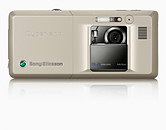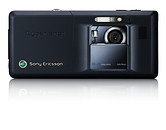Sony Ericsson K810 review: A Cyber-shot is reborn
A Cyber-shot is reborn
When it comes to cameraphones, the words K800 Cyber-shot always seem to come to mind. The time has come to finally forget it since the famous cameraphone has received a successor in the face of the spanking new Sony Ericsson K810. The same exciting 3.2 megapixel camera packed into a slimmer body and a brand new design. That's enough to start with, we think. Read on for our detailed review on the Sony Ericsson K810.




Sony Ericsson K810 official pictures
Key features
- Excellent 3.2 megapixel Cyber-shot™ camera with autofocus
- Xenon flash
- 64MB internal memory
- Memory card slot with hot swap functionality
- 3G support with video calls
- FM radio with RDS
- Bluetooth (with A2DP) and Infrared port
- Multi-tasking support
Main disadvantages
- Uncomfortable joystick and soft keys
- No EDGE (K818 has EDGE, but no 3G)
- Records video in the inadequate QCIF (176 x 144 pixels) resolution only
In February 2007 Sony Ericsson announced several new mobiles as an addition to their product line. Two of them are Cyber-shot cameraphones that would try to build on the success of the Sony Ericsson K800 model. We already reviewed the budget one - the Sony Ericsson K550 which didn't manage to impress. The Sony Ericsson K810 though is entirely a different story. It comes as an update to the K800. The upgrades over the previous version include a slimmer design due to the smaller active camera cover and dedicated camera options keys that allow for easier picture taking. While those upgrades don't seem much on paper, we are prepared to see whether the K810 really makes it worthwhile to dump your current K800 and go get a hold on the latest Sony Ericsson top-of-the-line cameraphone.
In much the same way that K800 had its twin EDGE brother in the face of K790, now the K810 model also has an EDGE twin - the Sony Ericsson K818 which will be targeted at the Chinese market. The Sony Ericsson K810 and the K818 will be available within Q2 2007 in two colors: Noble Blue and Golden Ivory.
Bear in mind that the test unit we got is a pre-release one and some bugs are really acceptable at this product development stage. Some options and applications may vary in the final retail version.
Heads on
Visually Sony Ericsson K810 doesn't differ much from the K800. It has the same form factor and pretty much the same color and size. It is several millimeters thinner than K800 and the most significant design change is the new keypad which is unusual for the recent Sony Ericsson line of phones as a whole.
The TFT display takes up the most part of the front panel. It has a mirror-like finish much like the K800 does and in much the same way it catches fingerprints rather easy. Above it there is the secondary VGA camera, the in-call speaker and two multimedia shortcut keys. Those were present in K800 too but here they are more prominent. Now they even have blue icons marking their functions. When the camera is on, the left one can be used to change the camera shoot mode, while the right one changes the Scene setting. When the camera is off, the left one opens the last picture you've browsed in fullscreen mode, while the right one opens the camera pictures in thumbnail mode.

Sony Ericsson K810 - speaker, secondary camera and multimedia shortcut key
| When it comes to cameraphones, the words K800 Cyber-shot always seem to come to mind. The time has come to finally forget it since the famous cameraphone has received a successor in the face of the spanking new Sony Ericsson K810 | <#AdRectangle#> |
Below the display there is the keypad with the usual Sony Ericsson soft keys and the newly-designed round metallic keys. The leftmost column of the alphanumeric keys serves the double purpose of dedicated camera keys for changing the picture resolution, auto focus mode, self-portrait timer and flash options. Icons with blue backlighting explain the function of each key. The keys "3" and "6" can also be used for zooming in and out when taking pictures. The alphanumeric keys design us rather controversial, but more on navigation and keypad user-friendliness is to come later on in the review.
The Sony Ericsson K810 left side features only the Memory Stick Micro M2 memory card slot and a dedicated Radio start/stop key. Viewing the K810 from this angle allows you to see that the active camera cover is much thinner and doesn't bulge from the body of the mobile the way it did on the Sony Ericsson K800.



K810 left side: memory card slot cap and radio shortcut key
The bottom part of the K810 features the regular Fast Port, the in-call microphone and an eyelet for attaching a wrist or neck strap. The top part of the device incorporates only the On/Off key which can also be used for fast switching of the ringing profiles.
The right side of the Sony Ericsson K810 hosts the camera shutter key which is styled in the way the keypad keys are and bulges slightly so it is easier to press and use. Next to it is the Infrared port and in the upper part of the right side we find the volume keys which can be used for zooming when taking or browsing pictures.



K810 right side: camera shutter key, Infrared port and volume keys
Flipping the phone over reveals the real eye candy - the 3.2 megapixel camera with its active cover, the loudspeaker and the Xenon flash. The back panel itself is made of matt plastic and except for the camera lens cover, it does not catch fingerprints that easily.




K810 back panel: camera, flash, loudspeaker
When we slide open the back over, the standard Sony Ericsson Li-Polymer BST-33 battery with a capacity of 950 mAh gets revealed. Right beneath it is the SIM card bed which is a regular Sony Ericsson one meaning that the SIM card is easy to slide in and hard to slide out. The same battery is used by Sony Ericsson K550, W850 and W880, just to mention a few. According to the manufacturer, the battery should last up to 400 hours of standby mode and up to 10 hours of talk time when used in GSM-only network. Unfortunately, we couldn't test the phone's battery life since we used it heavily during our tests and thus the battery life we experienced was not indicative for the real-life performance of the phone. But judging on other devices with this battery we think that it's a safe bet that with average usage the K810 battery would most probably max out at 4 days.
Generally we are quite pleased with the general ergonomics of the Sony Ericsson K810. It feels nice when held in hand and fits perfectly in your palm.
Reader comments
- pankaj
- 19 Apr 2012
- t}H
the material u used in k810i back side body is very low quality material.in indian climatic changes it hardly handle 2 0r 3 seasons of years without lamination.
- lex 0725930225
- 05 Jul 2011
- N7I
am disappointed with the joystick alex kenya
- MANI
- 01 Dec 2010
- utd
Am using this mobile from 2009 july....now my mobile is sleeping in service center....board problem..plzz improve the service sony


















